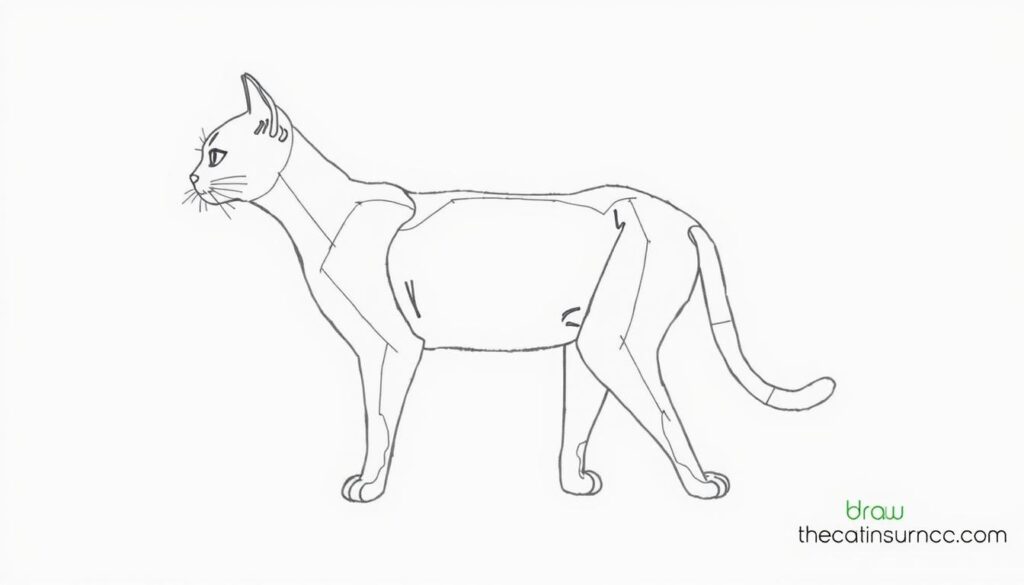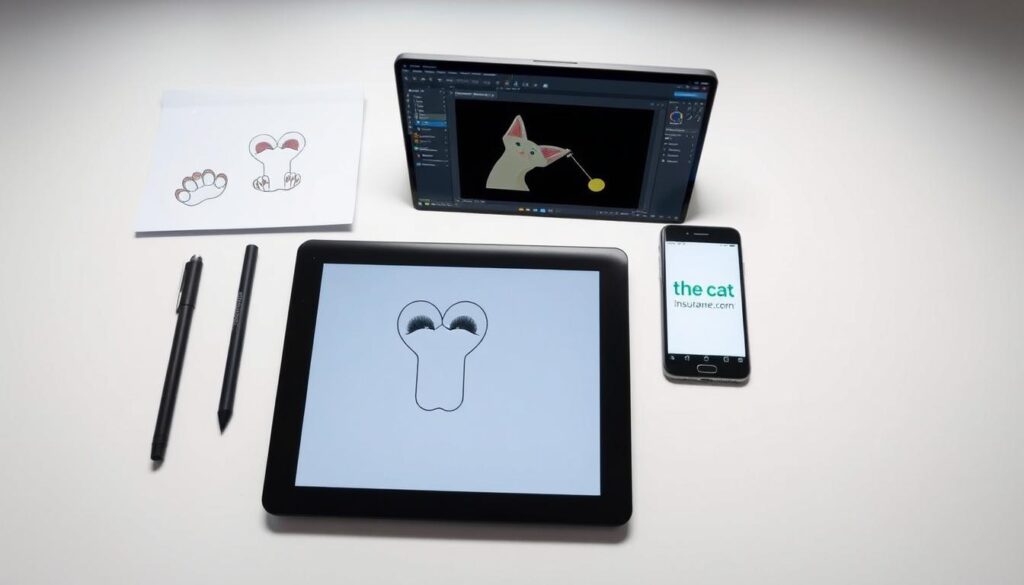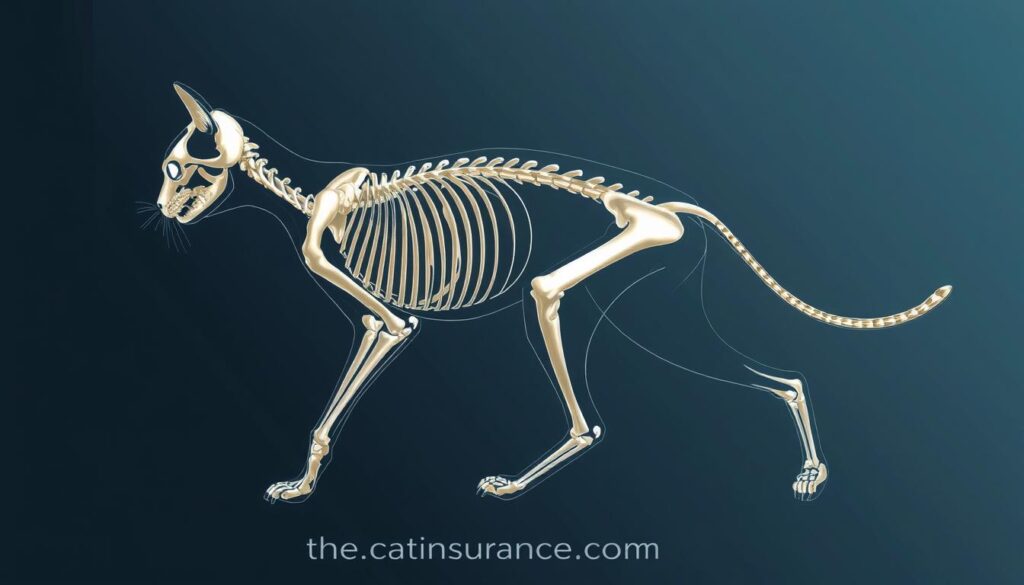Drawing a realistic cat needs a good grasp of its anatomy. Knowing the proportions and structure of genuine cat parts is key. This guide is for both beginners and experienced artists, making drawing a cat easy.
Understanding cat parts helps capture your feline’s essence. It’s also useful for cat owners to know their pet’s anatomy. For more on cat care and insurance, visit www.thecatinsurance.com.
Key Takeaways
- Understand the importance of cat anatomy for realistic drawing
- Learn the proportions and structure of a cat’s body
- Improve your drawing skills with a step-by-step guide
- Discover resources for cat care and insurance
- Create a believable piece of art with ease
Getting Started with Cat Drawing
Before you start drawing cats, make sure your workspace is ready. You’ll need the right tools and a comfy spot to draw. This will make your drawing time much better.
Materials You’ll Need
To draw a cat, you’ll need some basic stuff. You’ll need pencils (HB, 2B, 4B, 6B), a sketchbook or paper, an eraser, and a sharpener. For digital drawing, get a graphics tablet or use a drawing app on your device. Some artists use cat equipment parts or models for reference, but it’s not a must.
- Pencils (HB, 2B, 4B, 6B)
- Sketchbook or drawing paper
- Eraser
- Sharpener
- Graphics tablet or drawing app (optional)
Setting Up Your Workspace
Having a good workspace is key. Make sure it’s well-lit and comfy. You can use a drawing board or a flat surface, whichever you like.
Some artists prefer digital drawing tablets. They can work with or without a computer. Use a comfy chair and set your drawing surface at a good height. This avoids back or neck strain. If you’re using used cat parts or models, keep them close by.
Understanding Cat Anatomy: Essential Cat Parts
Cat anatomy is the base for realistic cat drawings. To draw a cat that looks real, you must know its structure. This includes the skeletal system, muscle groups, and breed-specific features.
Basic Skeletal Structure
The skeletal structure of a cat is its body’s framework. Knowing the cat parts like the skull, vertebrae, ribs, and limb bones is key. The skeletal system sets the cat’s proportions and posture.
The spine’s flexibility is due to its unique vertebral structure. This allows cats to move in unique ways.
Muscle Groups and Body Proportions
Muscles shape and move a cat’s body. Knowing where muscles are on the skeleton helps in drawing realistic poses. The body’s proportions, like torso to leg length, vary but follow certain rules.
Different Cat Breeds and Their Unique Features
Different cat breeds have unique looks. For example, the Maine Coon is sturdy, while the Siamese is sleek. Knowing these traits helps you draw various cats.
Learning about replacement cat parts like ear shape, coat length, and tail type improves your drawings.
| Breed | Body Type | Coat |
|---|---|---|
| Maine Coon | Muscular, sturdy | Long, flowing |
| Siamese | Sleek, slender | Short, fine |
Experts say, “Knowing cat anatomy well is crucial for capturing a cat’s essence in drawings.”
“The more you know about a cat’s inner workings and structure, the more accurately you can draw it.”
Basic Shapes: The Foundation of Your Cat Drawing
Many artists use basic shapes to draw cats. They break down a cat into simple shapes like circles, ovals, and rectangles. This makes their drawings more accurate and detailed.
Starting with Simple Geometric Forms
To draw a cat, start with circles, ovals, and rectangles. These shapes help you get the cat’s proportions right. For example, use a circle for the head and an oval for the body.
Tips for Using Basic Shapes:
- Use a circle for the cat’s head and an oval for the body.
- Sketch the legs and tail with rectangles.
- Make sure these shapes are in the right proportions for a realistic cat.
Creating a Basic Cat Silhouette
After setting up the basic shapes, create a cat silhouette. Connect these shapes to form a solid outline. This gives you a base to add more details later.
Here’s a simple table to show the basic shapes and their parts:
| Basic Shape | Cat Part |
|---|---|
| Circle | Head |
| Oval | Body |
| Rectangles | Legs and Tail |

Learning these basic shapes and silhouettes helps you draw realistic cats. You can draw from scratch or use digital tools. It’s like finding cat aftermarket parts or buying cat parts online to fix or customize something.
Drawing the Cat’s Head and Face
To make your cat drawing come alive, focus on the head and face. The head is complex, with the skull, facial features, and genuine cat parts. These parts show its expression and character.
Shaping the Skull and Facial Structure
The skull is the base of a realistic cat head. Start with a rough skull outline, thinking about the breed. For example, a Siamese has an angular head, and a British Shorthair has a rounder face.
Pay attention to proportions: the eyes are one-third down from the top. The nose and mouth form a gentle, triangular shape.
Positioning the Eyes, Nose, and Mouth
The eyes are the most expressive part of a cat’s face. Place them on either side of the head, right for the breed. The nose is slightly upturned, and the mouth is a gentle curve.
| Feature | Position | Characteristics |
|---|---|---|
| Eyes | One-third down from the top | Almond-shaped, slanted |
| Nose | Centered, slightly upturned | Small, pink or black |
| Mouth | Gentle curve below the nose | Subtle, with a slight indentation |
Adding Ears and Whiskers
Ears and whiskers make a cat’s face more expressive. Ears are triangular and pointed, fitting on either side of the head. Whiskers are long and stiff, helping the cat navigate.
By focusing on these details, you’ll create a cat drawing that shows its essence and personality.
Mastering Cat Parts: From Paws to Tail
Now that you’ve drawn the head and face, it’s time to focus on the rest. The torso, legs, and tail are key to a complete cat drawing. They bring your feline friend to life.
Drawing the Torso and Spine
The torso is the heart of your cat’s body. It supports the legs and tail. Start by sketching a gentle curve for the spine. Make sure it’s long enough for the cat’s posture.
The torso should be muscular and smooth. It should taper towards the hind legs. Pay attention to the proportions. The torso should match the head and legs.
Creating Natural-Looking Legs and Paws
Think about the cat’s stance and movement when drawing the legs. The front legs should be curved and muscular. The back legs are more powerful, especially for jumping or running.
For the paws, capture the softness and the way they touch the ground. Notice the details like the shape of the paw pads and the claws.
Perfecting the Tail
The tail shows a cat’s mood and emotion. Observe how it moves and balances the cat’s posture. The tail should match the body size and connect smoothly to the spine.(cat parts)
Use gentle, flowing lines to show its movement and flexibility. Whether it’s held high or wrapped around the body, it’s key.
Adding Detail to Your Cat Drawing
Now that you have the basic shape of your cat drawing, it’s time to add some detail. Details like fur textures and patterns can make your artwork more realistic and appealing.(cat parts)
Fur Textures and Patterns
To make your cat drawing more realistic, focus on fur textures and patterns. Use shading techniques like hatching and cross-hatching to mimic fur’s softness and flow. Look into the fur patterns of the cat breed you’re drawing, like tabby stripes or tortoiseshell mixes, to add authenticity.(cat parts)
Used cat parts like ears and tails can also be detailed with texture. For example, shading the fur around the ears can create depth. The tail can be detailed with stripes or other patterns.
Creating Depth and Dimension
To create depth and dimension in your cat drawing, use layering and shading techniques. Start by setting a light source in your drawing. Then, use shading to create light and shadow areas. This will give your drawing a three-dimensional look.(cat parts)
To add more depth, use layering techniques. Build up layers of shading and texture for a more nuanced and detailed drawing. This is especially effective for used cat parts like paws or noses, where subtle layering can enhance realism.(cat parts)
Trending Cat Poses and Expressions in 2023
In 2023, cat owners and artists are excited about the latest cat poses and expressions. These trends are all over social media. Knowing about them can make your cat drawings more interesting and relevant.(cat parts)
Popular Cat Postures on Social Media
Social media is full of cats showing off their unique personalities. Loafing is a big hit, where cats curl up tight to show they’re relaxed. Another favorite is the Stretch, where cats show off their flexibility by stretching out.(cat parts)
Adding these poses to your drawings can make them more relatable and cute.
Capturing Feline Emotions
Cats can show a range of emotions, from calm to playful. To capture these emotions in your drawings, focus on their facial expressions and body language. For example, a cat with its ears perked up and whiskers forward is curious or excited.
Using these details can help you show the emotion you want in your artwork.
Action Poses: Running, Jumping, and Playing
Action poses make your cat drawings come alive. Cats are agile, and drawing them in motion is captivating. When drawing action poses, think about the cat’s anatomy and how their equipment parts help them move.
A table summarizing key action poses and their characteristics can be helpful:
| Action Pose | Description | Key Features |
|---|---|---|
| Running | Cats in full stride, showcasing their speed. | Extended legs, arched back. |
| Jumping | Cats leaping through the air, capturing their agility. | Muscles tense, claws outstretched. |
| Playing | Cats engaged in playful activities, highlighting their interactive nature. | Eyes focused, tail twitching. |
By using these trending cat poses and expressions in your drawings, you can create artwork that cat lovers will enjoy.
New Coloring Techniques for Lifelike Cat Drawings
Want to make your cat drawings look real? Learn advanced coloring techniques to capture the details of feline fur and expression. Focus on the right colors, shading, and coat patterns to achieve lifelike results.
Choosing the Right Color Palette
Choosing the right colors is key to a believable cat drawing. Think about the cat’s breed, where it lives, and the mood you want to show. Warm colors can make a drawing feel cozy, while cool colors can be serene or mysterious.
- Look at reference images to see the cat’s natural colors.
- Try different color mixes to get the look you want.
- Think about how light affects the cat’s fur colors.
Advanced Shading and Highlighting Methods
Shading and highlighting add depth to your cat drawings. Learn how light affects fur to create realistic shading and highlights.
Key techniques include:
- Layer shades for a natural look.
- Use soft brushes or pencils for smooth transitions.
- Highlight where light naturally hits, like the head or spine.
Creating Different Coat Patterns
Each cat breed has its own coat pattern, from tabby stripes to tortoiseshell. Study the breed’s coat to draw it accurately.
Mastering these coloring techniques will make your cat drawings more realistic and engaging. They’ll grab the viewer’s attention.
Digital Tools and Apps for Drawing Cat Parts
The world of cat drawing has changed a lot with new digital tools. Now, artists can explore many creative options with just a few clicks.
Latest Software and Apps for Cat Artists
Adobe Photoshop and Clip Studio Paint are popular among cat artists. They offer features like layering and color management. This makes it easier to draw realistic cats. You can also find digital assets and 3D models online to improve your art.
Digital Drawing Techniques
Learning digital drawing techniques is key for realistic cat art. Techniques like layer blending and custom brushes can improve your work. Try out different tools and techniques to find what suits your style best.
Converting Traditional Drawings to Digital Format
Turning your traditional cat drawings into digital ones can be exciting. You can scan them and edit with digital software. Or, use a drawing tablet to create digital versions. This makes your art more flexible and shareable online.
| Software/App | Key Features | Usefulness for Cat Artists |
|---|---|---|
| Adobe Photoshop | Layering, texture manipulation, color management | High |
| Clip Studio Paint | Custom brushes, tone curves, layer management | High |
| Procreate | Gesture controls, layer blending, customizable brushes | Medium |

Common Mistakes to Avoid When Drawing Cats
To get better at drawing cats, knowing common mistakes is key. Spotting these errors can really boost your art’s quality.
Proportion and Anatomy Errors
Getting the proportions and anatomy wrong is a big mistake. Make sure the cat parts are the right size compared to each other. For example, the eyes should be about one-third of the way down from the top of the head. The ears should line up with the eyes and nose.
Knowing a cat’s skeleton and muscles is important for realistic drawings.
Unrealistic Fur and Texture Issues
Another common mistake is drawing fur that looks fake. To fix this, watch how the fur flows and use soft strokes to show its texture. Pay extra attention to the fur on the face, legs, and tail. It’s usually longer and more noticeable.
Expression and Posture Problems
Getting the cat’s expression and posture right is also key. Cats are agile and graceful, so studying their movements and body language is important. Here’s a table to help you spot and fix common mistakes:
| Common Mistake | Correction |
|---|---|
| Stiff or unnatural posture | Study cat movements and practice drawing different poses |
| Inaccurate facial expressions | Observe and draw different cat emotions, such as happiness, fear, or curiosity |
| Incorrect ear and tail positioning | Pay attention to how ears and tail reflect a cat’s mood and adjust accordingly |
By knowing these common mistakes and practicing, you can make your cat drawings better. You’ll create more realistic and engaging art.
Conclusion
To draw a cat, you need to know its body parts and how to shape them. It’s important to focus on the real parts and how they fit together. This makes your drawing look more like a real cat.
Remember, practice is key. Don’t get discouraged if your drawings aren’t perfect at first. Keep trying, and you’ll get better.
It’s also important to avoid mistakes like getting the proportions wrong. Looking at different cat parts or breeds can help you learn. This way, you can add more details to your drawings.
As you keep practicing, you’ll get better at showing the emotions and poses of cats. Drawing can be fun, whether you’re doing it for fun or as a job. The most important thing is enjoying the process of creating.
So, keep drawing cats. You’ll see your skills improve over time. Enjoy the journey of learning and creating.

